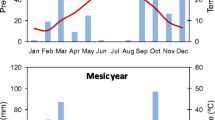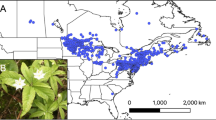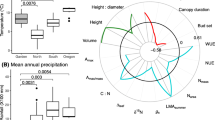Summary
Populations of the monocarpic plant Crepis tectorum were grown in a series of uniform environments to test the hypothesis that weedy populations are more r-selected than populations from a more natural habitat. Weedy populations exhibited a combination of r- and K-selected traits. The relatively rapid growth, the potential for a summer annual habit, and the relatively high fecundity that characterized at least one of the two weed populations studied were considered as r-selected traits favored in habitats of unpredictable duration. However, high levels of competition from other weedy species or from the crop in arable fields may explain at least some presumably K-selected traits observed in the weedy populations, e.g. relatively large seeds and late flowering in the summer. Results indicated that stress due to abiotic factors (strong winds, desiccation and nutrient deficiency) has been a more important selective factor than r- or K-selection, in non-weedy populations from calcareous grasslands (“alvars”) on the Baltic islands.
Similar content being viewed by others
References
Abrahamson WG, Gadgil M (1973) Growth form and reproductive effort in Goldenrods (Solidago, Compositae). Am Nat 107:651–661
Andersson S (1988) Limiting factors on seed production in Crepis tectorum ssp. pumila. Acta Phytogeogr Suec 76:9–20
Andersson S (1989) Variation in heteroblastic succession among populations of Crepis tectorum. Nord J Bot 8:565–573
Babcock EB (1947) The genus Crepis I–II. University of California Press, Berkeley, Los Angeles
Baker HG (1974) The evolution of weeds. Annu Rev Ecol Syst 5:1–24
Barrett SCH, Wilson BF (1981) Colonizing ability in the Echinochloa crus-galli complex (barnyard grass). I. Variation in life history. Can J Bot 59:1844–1860
Bazzaz FA (1986) Life history of colonizing plants: some demographic, genetic, and physiological features. In: Mooney HA, Drake JA (eds) Ecology of biological invasions of North America and Hawaii. Springer, Berlin Heidelberg New York, pp 96–110
Bengtsson K, Prentice HC, Rosén E, Moberg R, Sjögren E (1988) The dry alvar grasslands of Öland: ecological amplitudes of plant species in relation to vegetation composition. Acta Phytogeogr Suec 76:21–46
Bradshaw AD (1965) Evolutionary significance of phenotypic plasticity in plants. Adv Genet 13:115–155
Darwent AL, McKenzie JS (1978) Effects of planting date on the growth and development of narrow-leaved hawk's-beard. Can J Plant Sci 58:1087–1094
Gadgil M, Solbrig OT (1972) The concept of r and K selection: evidence from wild flowers and some theoretical considerations. Am Nat 106:14–31
Gaines MS, Vogt KJ, Hamrick JL, Caldwell J (1974) Reproductive strategies and growth patterns in Sunflowers (Helianthus). Am Nat 109:251–261
Grime JP (1979) Plant strategies and vegetation processes. Wiley and Sons, New York
Kruckeberg AR (1954) The ecology of serpentine soils: III. Plant species in relation to serpentine soils. Ecology 35:267–274
Law R, Bradshaw AD, Putwain PD (1977) Life-history variation in Poa annua. Evolution 31:233–246
Leverich WJ, Levin DA (1979) Age-specific survivorship and reproduction in Phlox drummondii. Am Nat 113:881–903
Levin DA (1974) The oil content of seeds: an ecological perspective. Am Nat 108:193–206
Linhart YB (1974) Intra-population variation in annual plants. I. Veronica peregrina L. raised under non-competitive conditions. Evolution 28:232–243
MacArthur RH, Wilson EO (1967) The theory of island biogeography. Princeton University Press, Princeton
McNaughton SJ (1975) r and K-selection in Typha. Am Nat 109:251–261
Pettersson B (1958) Dynamik och konstans i Gotlands flora och vegetation. Acta Phytogeogr Suec 40:1–288
Pianka ER (1970) On r- and K-selection. Am Nat 104:592–597
Reynolds DN (1984) Population dynamics of three annual species of alpine plants in the Rocky Mountains. Oecologia (Berlin) 62:250–255
Ritland K, Jain S (1984) A comparative study of floral and electrophoretic variation with life history variation in Limnanthes alba (Limnanthaceae). Oecologia (Berlin) 63:243–251
Rosén E (1984) Some short-term changes in the dynamics of limestone grasslands of South Öland, Sweden. Nova Acta R Soc Sci Upsal, Ser V:C 3:189–205
Salisbury EJ (1942) The reproductive capacity of plants. Bell, London
Schaal BA, Leverich WJ (1982) Survivorship patterns in an annual plant community. Oecologia (Berlin) 54:149–151
Schulze ED, Chapin FS (1986) Plant specialization to environments of different resource availability. In: Schulze ED, Zwölfer H (eds) Potentials and limitations of ecosystem analysis. Springer, Berlin Heidelberg New York, pp 120–148
Sokal RR, Rohlf FJ (1981) Biometry, 2nd edn. Freeman, San Francisco
Stearns SC (1977) The evolution of life history traits: A critique of the theory and a review of the data. Annu Rev Ecol Syst 8:145–171
Sterner R (1938) Flora der Insel Öland. Acta Phytogeogr Suec 9:1–169
Svensson R, Wigren M (1986) A survey of the history, biology and preservation of some retreating synanthropic plants. Acta Univ Ups Symb Bot Ups XXV:4
Wanner H, Bruhin A (1950) Über die Photoperiodische Reaktion von Crepis-Arten. Ber Schweiz Bot Ges 60:401–403
Werner PA, Platt WJ (1976) Ecological relationships of co-occurring glodenrods (Solidago, Compositae). Am Nat 110:959–971
Widén B (1980) Flowering strategies in the Helianthemum oelandicum (Cistaceae) complex on Öland, Sweden. Bot Not 133:99–115
Wilbur HM (1976) Life history evolution in seven milkweeds of the genus Asclepias. J Ecol 64:223–240
Wilkinson L (1986) SYSTAT: The system for statistic. SYSTAT, Inc, Evanston, Ill
Author information
Authors and Affiliations
Rights and permissions
About this article
Cite this article
Andersson, S. Life-history variation in Crepis tectorum (Asteraceae). Oecologia 80, 540–545 (1989). https://doi.org/10.1007/BF00380079
Received:
Issue Date:
DOI: https://doi.org/10.1007/BF00380079




